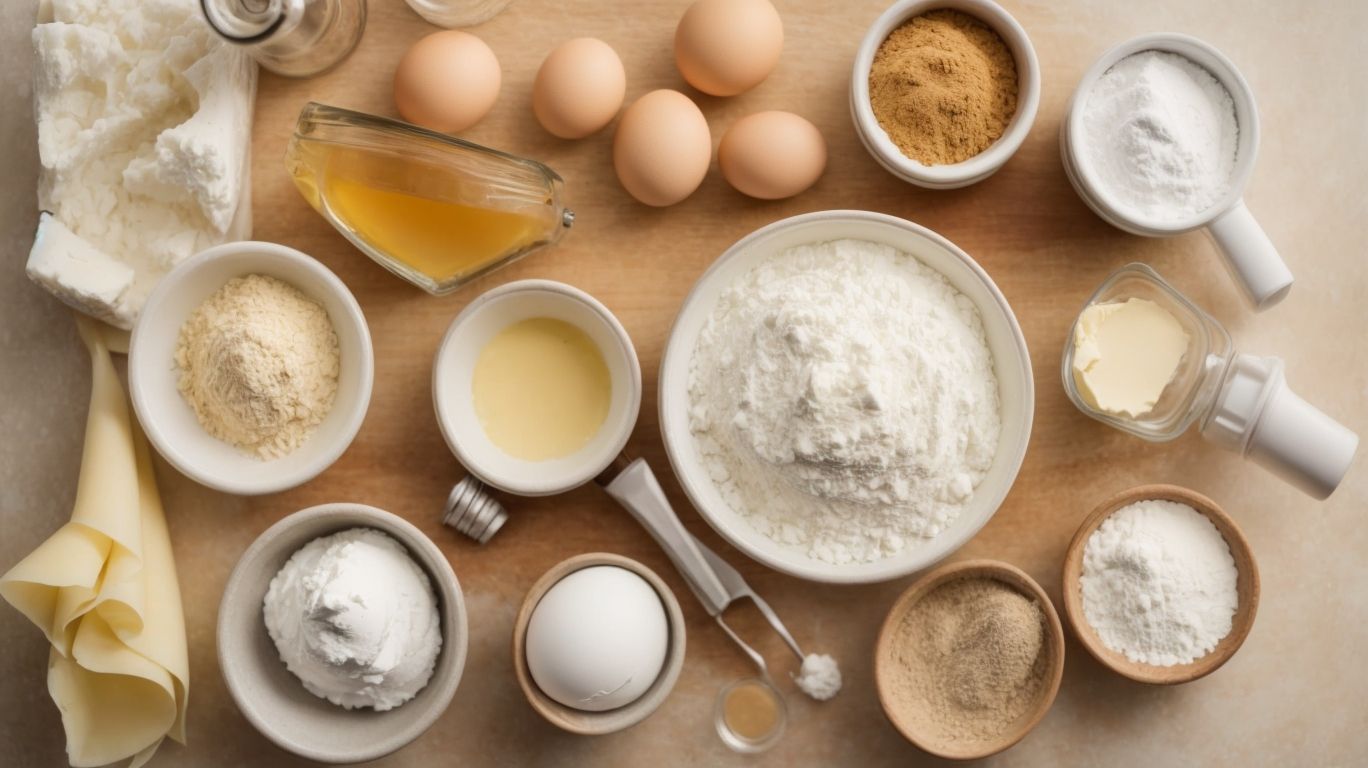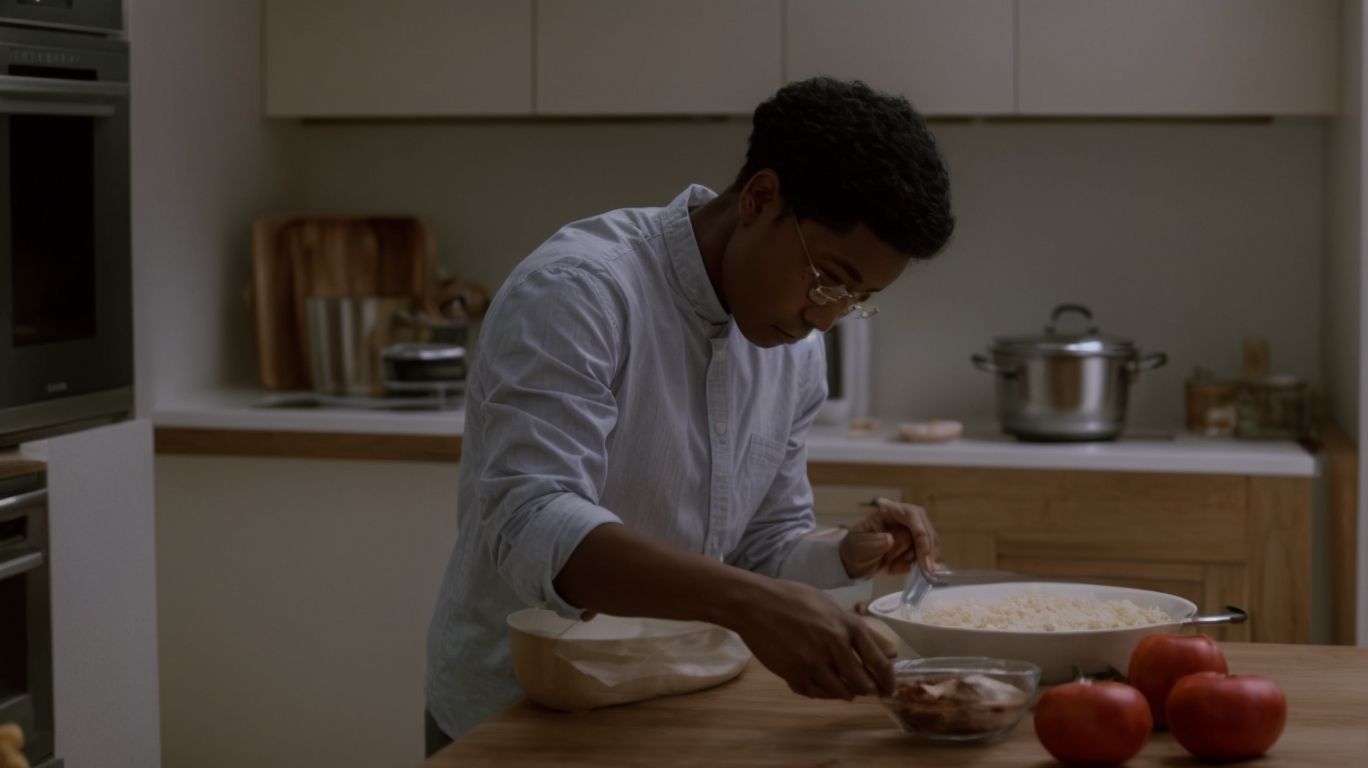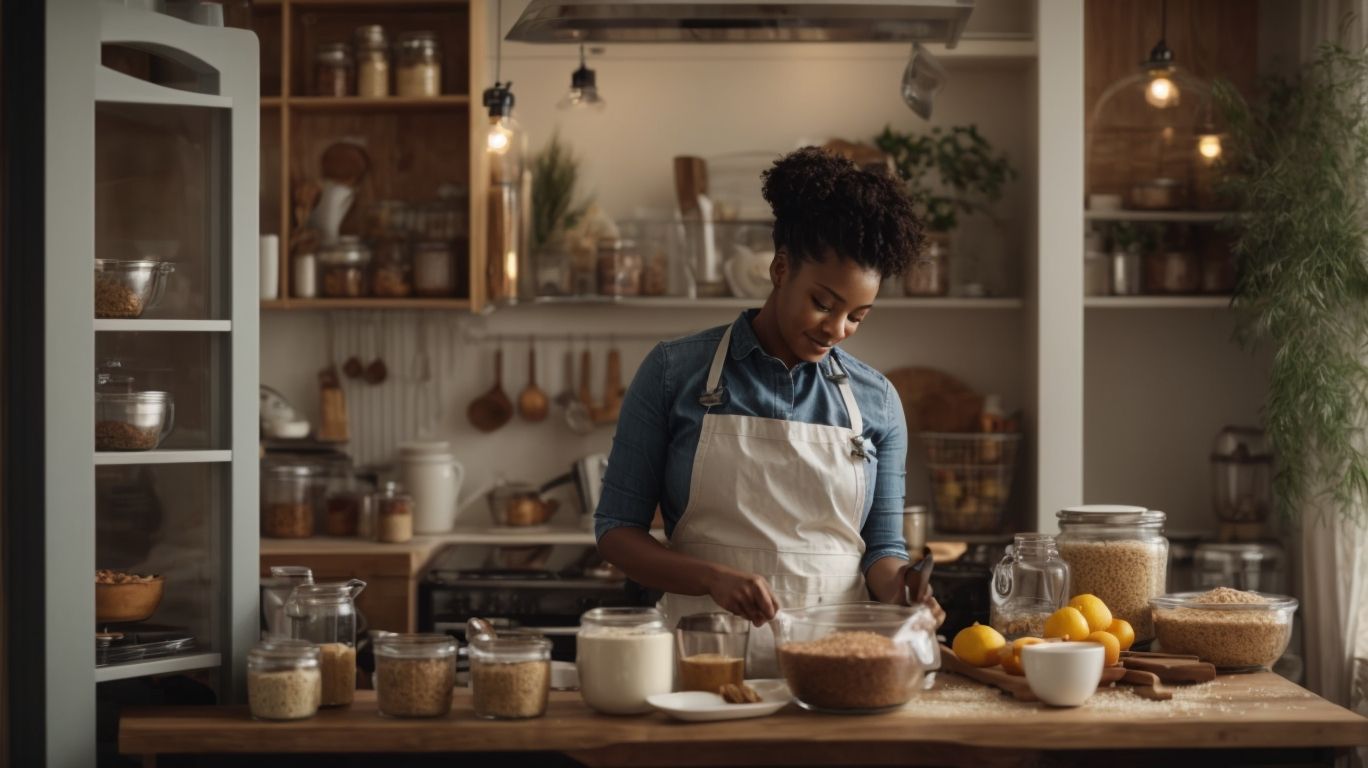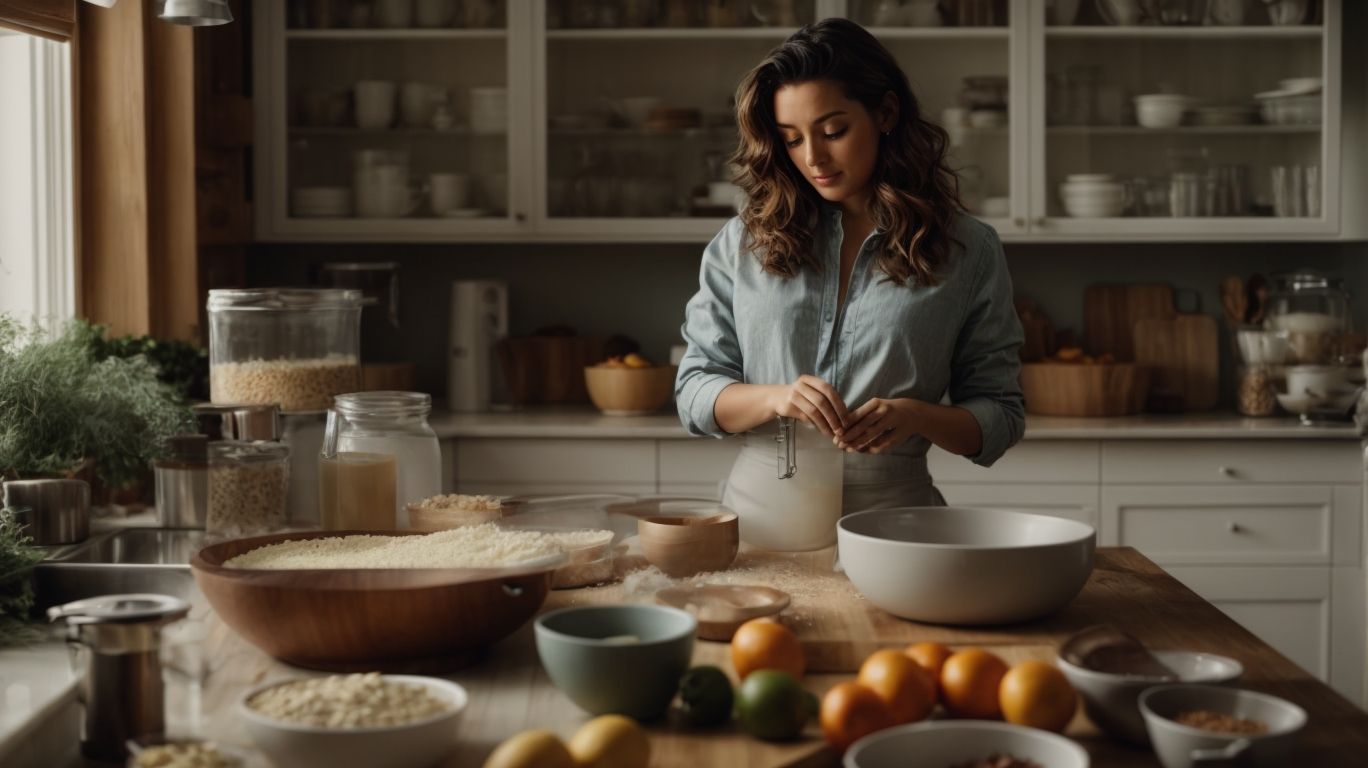How to Bake Without a Recipe?
Are you tired of sticking to traditional baking recipes and craving more creativity in the kitchen?
We will explore the art of baking without a recipe and the many reasons why you should give it a try. From the basics of flour, fat, sugar, and eggs to the techniques of mixing and experimenting with flavors, we will guide you on how to create your own unique baking creations.
Stay tuned for tips and tricks for successful baking without a recipe and get ready to unleash your inner pastry chef!
Key Takeaways:
What Does It Mean to Bake Without a Recipe?

Credits: Poormet.Com – Elijah Hill
Baking without a recipe entails creating delectable treats without adhering to traditional ingredient measurements or step-by-step instructions.
It allows your creativity to flourish in the kitchen, giving you the freedom to experiment with different ingredients and flavor combinations. Without the constraint of following a recipe, you can adjust the texture, sweetness, and overall taste to suit your preferences, resulting in a truly unique creation.
By exploring new ingredients or modifying quantities on the fly, you can discover unexpected flavor pairings and textures that may even become your signature baking style. This process of improvisation not only enhances your culinary skills but also adds a personal touch to your baked goods, making them stand out from store-bought treats.
Why Bake Without a Recipe?
Baking without a recipe provides an avenue for culinary exploration, allowing individuals to experiment with flour, water, sugar, and other essential ingredients to craft diverse delicacies.
One of the key benefits of this approach is the freedom it grants bakers to tailor their creations to suit personal tastes and dietary requirements. Without the confines of strict measurements and instructions, bakers can innovate with unique flavor combinations and textures, resulting in truly one-of-a-kind treats.
Moreover, baking without a recipe encourages creativity and problem-solving skills as individuals learn to adjust ingredients and techniques based on visual cues and experience rather than following a set formula.
From experimenting with different types of flour to incorporating unexpected ingredients, the possibilities are endless when one ventures into the world of recipe-free baking.
Creativity and Personalization
The essence of baking without a recipe lies in the freedom to experiment with ratios, inspired by culinary experts such as Michael Ruhlman, to craft personalized delights like Victoria sponge cake enriched with nuts.
Delving into the realm of creative baking, the importance of understanding ingredient ratios becomes evident. By grasping the impact of each component on the final product, aspiring bakers can elevate their creations to new heights of flavor and texture. Renowned chefs like Michael Ruhlman emphasize the art of customization, showcasing how slight adjustments can transform a traditional recipe into a unique culinary masterpiece.
Flexibility and Adaptability
Baking without a recipe fosters flexibility and adaptability in the kitchen, allowing for ingredient swaps, creative spice combinations, and intuitive measuring techniques favored by culinary innovators like Alice Medrich and the Epi Test Kitchen.
When you venture into baking without a recipe, you open the door to a world of culinary experimentation. Ingredient swaps become second nature, enabling you to tailor your creations to suit your taste preferences or work with what you have on hand. By incorporating a variety of spices, you can elevate your baked goods to new heights, adding depth and complexity of flavors. Embracing non-traditional measuring methods, such as using visual cues or the feel of the dough, enables you to rely on your instincts and creativity.
Experts like Alice Medrich and the Epi Test Kitchen encourage this freestyle approach to baking, emphasizing that it not only unlocks your creativity but also enhances your understanding of ingredients and techniques. They inspire home bakers to trust their instincts and embrace the unpredictable nature of experimentation in the kitchen. So, next time you bake, consider stepping outside the bounds of traditional recipes and embark on a journey of discovery and innovation in your own culinary endeavors.
Time and Cost Efficiency
One of the key advantages of baking without a recipe is the time and cost efficiency it offers, with techniques like sifting, detailed testing notes, and creative uses of parchment paper advocated by baking authority Rose Levy Beranbaum.
Beranbaum, a distinguished baker renowned for her precise and scientific approach to baking, firmly believes that the freedom to experiment in the kitchen without strict guidelines can lead to unparalleled culinary discoveries. Her emphasis on meticulous testing notes enables bakers to refine their techniques and understand the nuances of ingredients, resulting in consistently superior baked goods.
The ingenious application of parchment paper in unconventional ways, as suggested by Beranbaum, can revolutionize baking processes by simplifying cleanup and enhancing presentation. By utilizing parchment paper for creative purposes such as shaping dough, lining pans, and even crafting piping bags, bakers can streamline workflows and achieve professional-quality results effortlessly.
What Are the Basic Ingredients and Techniques for Baking Without a Recipe?
To bake without a recipe successfully, mastering the use of basic ingredients like eggs and fat, coupled with techniques such as sifting and utilizing non-stick surfaces, is essential.
Regarding baking without a recipe, eggs play a crucial role in providing structure, moisture, and richness to baked goods. The varying functions of eggs, whether as a leavening agent or a binder, make them critical in achieving the desired texture and consistency. Similarly, fats like butter or oil contribute to tenderness, flavor, and moisture, enhancing the overall quality of the baked creations.
Sifting, often overlooked, ensures the even distribution of ingredients, removes lumps, and aerates the flour, resulting in lighter and fluffier baked goods. Embracing non-stick surfaces, whether in the form of pans or parchment paper, simplifies the baking process by preventing sticking and facilitating easy removal of the finished treats.
Flour
Flour serves as the foundation for countless baking creations, from delicate pastries to homemade fresh pasta, with precise measuring techniques advocated by baking expert Alice Medrich.
Understanding the role of flour in baking goes beyond being just a basic ingredient; it is the key element that defines the texture, structure, and overall quality of the final product. Different types of flour, such as all-purpose, cake flour, or bread flour, offer unique characteristics that cater to specific baking needs. Whether creating a light and airy cake or a chewy bread loaf, the type of flour used can significantly impact the end result.
The versatility of flour extends to a wide range of baked goods, offering a canvas for culinary creativity. From flaky croissants to crispy cookies, the possibilities are endless when it comes to incorporating flour into various recipes. In the realm of pasta-making, the right flour blend can transform a simple mixture of water and eggs into silky strands of fresh pasta that are unrivaled in taste and texture.
While flour is a staple ingredient in most kitchens, achieving consistent and delicious results relies heavily on accurate measuring methods. The importance of measuring flour correctly cannot be overstated, as even a slight deviation in quantity can lead to significant changes in the final outcome. Investing in a reliable kitchen scale or using the spoon-and-level method recommended by Alice Medrich ensures that the flour is measured accurately, guaranteeing consistent results with each bake.
Fat
Fats play a crucial role in baking without a recipe, contributing to the richness and texture of pastries, Victoria sponge cakes, and airy meringues.
One of the key reasons fats are essential in baking is their ability to provide moisture and tenderness to baked goods. When fats are mixed into the flour, they help coat the gluten proteins, preventing them from forming long, tough strands, resulting in a tender crumb.
Additionally, fats contribute to the flavor and overall mouthfeel of baked treats. Butter, for example, lends a rich, buttery taste, while lard can add a savory note to certain pastries.
For a classic Victoria sponge cake, the right balance of fat is crucial to achieve that perfect, moist crumb with just the right amount of lightness.
Sugar
Sugar serves as a versatile ingredient in crafting delectable desserts, with expert insights from baking authority Rose Levy Beranbaum guiding the balance of sweetness in various confections.
Regarding baking, sugar plays a crucial role beyond just adding sweetness. It contributes to the texture, moisture, and color of baked goods, making them more enticing to the palate. In the absence of a specific recipe, understanding how different types of sugar, such as granulated, brown, powdered, or even alternatives like honey or maple syrup, can be used interchangeably based on the desired outcome.
According to Rose Levy Beranbaum, achieving the perfect sweetness level in desserts involves a delicate balance. Too much sugar can overpower other flavors, while too little can lead to a lackluster taste. Her professional tip emphasizes the importance of properly measuring sugar, and knowing when to adjust for variations in ingredients or personal preferences.
Eggs
Eggs are a versatile ingredient essential for binding, leavening, and enhancing flavors in baked goods, as praised by the discerning Epi readers for their role in elevating the overall taste profile.
Eggs play a crucial role in binding ingredients together, providing structure and stability to baked treats. They contain proteins that help create a network that holds everything together, preventing crumbly textures.
Eggs contribute to leavening, helping baked goods rise by trapping and incorporating air during mixing. This process leads to lighter, fluffier textures in cakes, muffins, and other delights.
Not only do eggs improve texture and structure, but they also enrich the flavors of baked goods. The proteins and fats in eggs add richness and depth, enhancing the overall taste experience for those indulging in these delicious creations.
According to feedback from Epi readers, eggs aren’t just a baking necessity but a key player in creating those delightful flavors that leave a lasting impression. Whether it’s a moist cake or a perfectly risen soufflé, eggs bring that magic touch to elevate the final outcome and satisfy the taste buds of those enjoying these delectable treats.
Baking Powder/Soda
Baking powder and baking soda are essential leavening agents that contribute to the texture, flavor, and rise of baked goods, enhancing the overall culinary experience.
Regarding baking, baking powder and baking soda play crucial roles. Baking powder is a combination of baking soda and an acid, usually cream of tartar. When mixed with liquid and heat, it releases carbon dioxide bubbles, causing the dough or batter to rise. On the other hand, baking soda requires an acidic ingredient such as yogurt or buttermilk to activate its leavening properties. This reaction produces carbon dioxide as well, aiding in the expansion of the baked goods.
The leavening action of these agents is what creates the airy, light texture in cakes, muffins, and quick breads. Without them, baked goods would be dense and flat. Their impact extends beyond just rising; they also influence the flavor profile. Baking powder tends to be neutral in taste, while baking soda can contribute a slight metallic flavor if not properly balanced with acidic ingredients.
Mixing Techniques
Mastering diverse mixing techniques is crucial for achieving the desired textures, flavors, and appearances of baked delights like the classic Victoria sponge cake infused with nuts and spices.
Regarding baking without a recipe, understanding how different mixing methods influence the end result is key. Incorporating folding techniques gently combines ingredients like flour and nuts without deflating the batter, resulting in a light, airy texture.
On the other hand, creaming butter and sugar together creates a smooth, creamy base perfect for rich, decadent cakes.
Beating eggs until light and fluffy adds volume and structure, enhancing the overall rise of the cake. By experimenting with these techniques, bakers can elevate their creations beyond the ordinary.
How to Create Your Own Baking Recipes Without a Recipe?
Crafting personalized baking recipes without a recipe starts by building upon a base recipe, infusing unique flavors, and meticulously documenting testing notes for future refinements.
When diving into the realm of creating original baking recipes sans guidance, the initial step is crucial – selecting a reliable base recipe that aligns with the desired outcome. Base recipes provide a solid foundation to work from, ensuring consistent results.
Next comes the exciting phase of experimentation, where bakers can get creative with enhancing flavors through the addition of spices, extracts, or unique ingredients. The magic truly unfolds when these adjustments are matched with keen observations, recorded in meticulous testing notes that serve as a roadmap for further tweaks and enhancements. In the culinary journey of crafting bespoke recipes, these notes play a vital role in unlocking the full potential of each creation.
Start with a Base Recipe
Initiating the creation of personalized baking recipes without a recipe involves using a trusted base recipe as a foundation, integrating improvisations inspired by culinary maestros like Michael Ruhlman, and refining techniques like sifting for optimal results.
By starting with a reliable base recipe, you establish a solid framework to build upon, ensuring consistent results and a reliable starting point. Drawing inspiration from renowned experts such as Michael Ruhlman can provide valuable insights into flavor combinations, ingredient pairings, and innovative techniques that elevate your creations. Incorporating elements like unique flavor profiles, different textures, or unconventional ingredients can add a personal touch that sets your recipes apart.
Experiment with Flavors and Add-ins
Pushing the boundaries of flavor and texture involves experimenting with a myriad of spices and add-ins, drawing inspiration from culinary innovators like the Epi Test Kitchen, and adopting precise measuring techniques for consistent results.
Exploring new combinations of spices and ingredients can take your baking endeavors to exciting heights, revealing unique and delightful flavors.
The Epi Test Kitchen exemplifies this approach, constantly testing and refining recipes to ensure a perfect balance of tastes and textures. By incorporating unexpected add-ins, such as cardamom or nutmeg, into your baking repertoire, you can elevate traditional recipes to new levels of sophistication. Embracing the art of accurate measuring not only enhances the final product’s flavor but also guarantees a successful integration of diverse elements for a harmonious outcome.
Adjust for Texture and Consistency
Fine-tuning baking recipes for optimal texture and consistency involves heeding expert advice from baking authority Rose Levy Beranbaum, incorporating nuts for added richness, and perfecting meringues for delightful lightness.
Adjusting recipes according to the desired texture can make a world of difference in the final baked goods. Understanding how ingredients interact and how they affect the outcome is crucial. Rose Levy Beranbaum emphasizes the significance of precise measurements and techniques in achieving the perfect consistency.
Adding nuts to recipes not only introduces a variety of textures but also enhances the overall flavor profile. Whether you prefer the crunch of walnuts or the creaminess of almonds, nuts provide a delightful contrast to softer components. Regarding meringues, beating egg whites until they reach stiff peaks, while gradually adding sugar, is key for achieving that light and airy texture.
Keep Notes and Make Adjustments for Next Time
Maintaining detailed testing notes, utilizing parchment paper for easy cleanup, and making real-time adjustments to batter consistency are crucial practices for refining and iterating on baking recipes without a recipe.
Keeping thorough testing notes helps in tracking the precise measurements, ingredients, and techniques used during recipe experimentation, allowing for systematic improvements and avoiding repetitive mistakes.
Parchment paper, a versatile tool in baking, not only prevents sticking but also simplifies cleanup, making it essential for lining pans, creating makeshift piping bags, or even wrapping delicate items for gentle baking or roasting.
When baking without a recipe, adjusting batter thickness through additional flour or liquids on the fly is key to achieving the desired texture, rising, and consistency.
Tips and Tricks for Successful Baking Without a Recipe

Credits: Poormet.Com – Zachary Baker
Executing flawless baking creations without a recipe requires mastering techniques like sifting, precise measuring, and drawing insights from culinary experts like the Epi Test Kitchen for exceptional results.
When venturing into the adventurous realm of baking without a recipe, it’s essential to understand that precision is key. The process of sifting ingredients not only aerates the components but also ensures uniformity and avoids clumping, resulting in a lighter and more tender crumb in your baked goods. Accurate measuring practices significantly impact the final outcome, as even minor discrepancies in quantities can alter the texture and taste of your creations.
Seeking guidance from culinary professionals, such as the Epi Test Kitchen, can provide invaluable tips and tricks to elevate your baking game to the next level. Remember, practice makes perfect in the delightful world of baking!
Use a Kitchen Scale
Employing a kitchen scale for precise measurements, as recommended by baking luminary Alice Medrich, ensures the accurate incorporation of essential ingredients like flour, sugar, and eggs for consistent and delectable baked goods.
Using a kitchen scale not only guarantees the correct ratios of ingredients but also leads to more uniform textures and flavors in your recipes. By accurately measuring items such as chocolate chips or nuts, you avoid overpowering a delicate batter or dough with too much of these add-ins, affecting the final outcome. Alice Medrich’s emphasis on painstakingly weighing rather than relying solely on volume measurements resonates with professional bakers and novice enthusiasts alike, underscoring the significance of precision in achieving exceptional baked treats.
Understand the Science of Baking
Delving into the scientific aspects of baking, inspired by culinary virtuosos like Michael Ruhlman, enhances pastry creations with perfect sifting techniques and flavor combinations that elevate culinary experiences.
Understanding the fundamentals of baking science is akin to unraveling the intriguing mysteries of creating delectable pastries and desserts. Michael Ruhlman, a celebrated culinary expert, emphasizes the significance of precision and technique in achieving pastry perfection. Through his insights, aspiring bakers can grasp the intricacies of ingredient interactions, temperature control, and the art of balancing flavors to craft memorable treats.
The art of precise sifting plays a pivotal role in achieving the desired lightness and texture in baked goods. By aerating flour and incorporating air, sifting ensures a uniform distribution of ingredients, leading to a consistent and tender crumb in cakes and pastries.
Regarding baking without a recipe, understanding flavor harmonization is key. Experimenting with complementary tastes and aromas can result in unique and delightful creations that showcase your individual creativity. Ruhlman’s philosophy underscores the importance of developing a nuanced understanding of how different flavors interact and complement each other, enabling bakers to improvise with confidence and finesse.
Don’t Be Afraid to Fail
Embracing the possibility of failure is an integral part of the baking process, as advocated by baking authority Rose Levy Beranbaum, emphasizing the importance of learning from mistakes and refining recipes through meticulous testing notes for future success.
When venturing into the world of baking without a recipe, it’s vital to maintain a resilient mindset. Every baking journey is a learning experience, and setbacks are opportunities for growth. As Rose Levy Beranbaum rightly puts it, failure is not an endpoint but a stepping stone to improvement. By embracing the challenges, one can unlock creativity, discover new flavor combinations, and elevate baking skills to new heights.
To truly master the art of improvisational baking, keeping detailed testing notes is a game-changer. These notes serve as a roadmap, documenting what works and what doesn’t in each baking experiment. Reviewing and analyzing these records enable bakers to make informed adjustments, leading to refined recipes and consistently delicious results.
Conclusion

Credits: Poormet.Com – William Baker
The art of baking without a recipe transcends traditional boundaries, offering a realm of flavor experimentation, meticulous sifting techniques, and a plethora of delectable desserts inspired by culinary innovation from the Epi Test Kitchen.
Baking without a recipe allows for endless creativity in the kitchen, where aspiring bakers can infuse unique flavors into their creations, ranging from classic vanilla and chocolate to exotic combinations like cardamom pistachio or lavender honey.
Mastering the technique of sifting is crucial in achieving the perfect texture and crumb in baked goods, ensuring a light and airy result that melts in your mouth with each bite.
The Epi Test Kitchen’s influence can be seen in a diverse array of desserts, including decadent cakes, mouthwatering tarts, velvety custards, and delicate pastries, showcasing the versatility and expertise of the culinary team.
Frequently Asked Questions
How to Bake Without a Recipe?
1. Can I bake without following a recipe?
Yes, you can definitely bake without following a recipe. Baking without a recipe allows you to be creative and experiment with different flavors and ingredients.
How to Bake Without a Recipe?
2. What are the benefits of baking without a recipe?
Baking without a recipe allows you to customize and personalize your baked goods according to your taste. It also helps you to become a better cook by relying on your instincts and creativity.
How to Bake Without a Recipe?
3. Do I need to have advanced baking skills to bake without a recipe?
No, you do not need to have advanced baking skills to bake without a recipe. All you need is a basic understanding of baking techniques and a willingness to experiment.
How to Bake Without a Recipe?
4. What are some tips for baking without a recipe?
Start by understanding the basics of baking, such as the proper measurements and ratios of ingredients. Also, make sure to taste as you go and adjust accordingly.
How to Bake Without a Recipe?
5. Can I still achieve delicious baked goods without a recipe?
Absolutely! With practice and experimentation, you can create delicious baked goods without following a recipe. Remember to trust your instincts and taste as you go.
How to Bake Without a Recipe?
6. Is baking without a recipe suitable for beginners?
Baking without a recipe may be challenging for beginners, but it is a great way to develop your baking skills and creativity. Start with simple recipes and gradually experiment with more complex ones.

